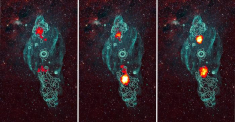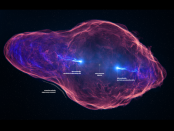
The H.E.S.S. observatory in Namibia detected very high energy gamma rays coming from the plasma beams ("jets") of the microquasar SS 433, and located the exact location in them of one of the most efficient particle accelerators in the world. galaxy. Even better... By comparing gamma ray images at different energies, it was possible to estimate for the first time the speed of the jet far from its emission site. Enough to identify the mechanism that accelerates the particles so effectively. Results published in the latest issue of the journal Science.
SS 433 is one of the most intriguing objects in the Milky Way. At its heart, a black hole sucks up material from a closely orbiting companion star, creating a very hot accretion disk. Two oppositely directed plasma beams (“jets”) are propelled in a spiral perpendicular to the disk surface at a speed greater than a quarter of the speed of light. The H.E.S.S. observatory. in Namibia managed to detect very high energy gamma rays coming from the jets of SS 433 and to locate the exact location, within the jets, of one of the most efficient particle accelerators in the galaxy. By comparing gamma-ray images at different energies, scientists from the H.E.S.S. collaboration. have revealed the motion and dynamics of relativistic jets in our own galaxy, providing valuable insight into these extraordinary astrophysical phenomena. The results are published in the latest issue of the journal Science.
The APC very high energy gamma astronomy team is among the pioneers in this field of research through its contribution to the Themistocle, CAT and Celeste pilot experiments in the Pyrénées Orientales in France, as well as through its involvement in the design, construction and operation of the H.E.S.S. array of telescopes in Namibia.
APC teams are heavily involved in the preparation of the international CTA observatory, which will be the next step in the exploration of the very high energy gamma-ray sky through two sites, in the Canary Islands and Chile.
In pictures:
|
Composite images of SS 433 showing three different gamma-ray energy ranges. In green, radio observations display the Manatee Nebula with the microquasar visible as a bright dot near the center of the image. Solid lines show the outline of the x-ray emis-sion from the central regions and the large scale jets after their reappearance. Red colors represent the gamma-ray emission detected by H.E.S.S. at a) low (0.8-2.5 TeV, left), b) in-termediate (2.5-10 TeV, middle) and c) high (>10 TeV, right) energies. The position of the gamma-ray emission shifts further from the central launching site as the energy decreases. CREDIT Background: NRAO/AUI/NSF, K. Golap, M. Goss; NASA’s Wide Field Survey Ex-plorer (WISE); X-Ray (green contours): ROSAT/M. Brinkmann; TeV (red colors): H.E.S.S. collaboration. |
Artist's impression of the SS 433 system, depicting the large-scale jets (blue) and the surrounding Manatee Nebula (red). The jets are initially observable only for a short dis-tance from the microquasar after launch — too small to be visible in this picture. The jets then travel undetected for a distance of approximately 75 light-years (25 parsecs) before un-dergoing a transformation, abruptly reappearing as bright sources of non-thermal emission (X-ray and gamma-ray). Particles are efficiently accelerated at this location, likely indicating the presence of a strong shock: a discontinuity in the medium capable of accelerating particles. CREDIT Science Communication Lab for MPIK/H.E.S.S. |
|
Artist’s impression video visualization of the SS 433 system and summary of the main results of the paper CREDIT Science Communication Lab for MPIK/H.E.S.S. |
Contacts APC
Arache Djannati-Ataï
+ 33 1 57 27 61 59, djannati![]() in2p3.fr
in2p3.fr
Terrier Régis
+ 33 1 57 27 60 79, rterrier![]() apc.in2p3.fr
apc.in2p3.fr
See full article on IN2P3 web site (in French)
See the PR in English
Services/Groupes:
- Astrophysique à Haute Energie


